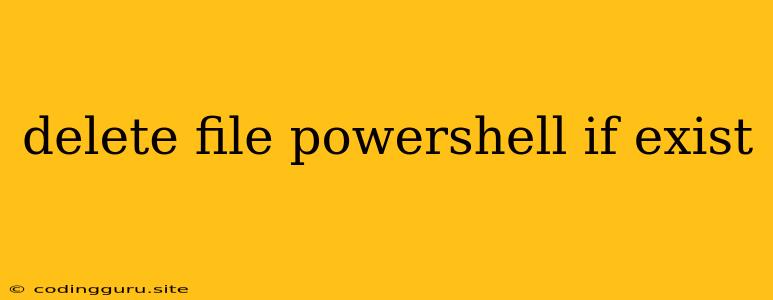How to Delete a File in PowerShell if it Exists
PowerShell is a powerful command-line shell and scripting language for Windows. It provides a rich set of cmdlets (commands) to manage various aspects of your system, including file management. One common task is deleting a file if it exists.
The Importance of Checking for File Existence
Before attempting to delete a file, it's crucial to check if it actually exists. Deleting a non-existent file will result in an error, potentially disrupting your script execution. This is where PowerShell's Test-Path cmdlet comes in handy.
Using Test-Path and Remove-Item
Here's a basic example of how to delete a file if it exists:
$filePath = "C:\MyFile.txt"
# Check if the file exists
if (Test-Path $filePath) {
# Delete the file
Remove-Item $filePath
Write-Host "File deleted successfully!"
} else {
Write-Host "File does not exist."
}
In this script:
$filePathstores the path to the file you want to delete.Test-Path $filePathchecks if the file at the specified path exists.ifstatement executes theRemove-Itemcmdlet only if the file exists.Remove-Item $filePathdeletes the file.Write-Hostprovides user-friendly messages indicating the outcome.
Handling Errors
Even if you check for file existence, errors can occur during the deletion process. You can handle these errors using a try...catch block:
$filePath = "C:\MyFile.txt"
try {
if (Test-Path $filePath) {
Remove-Item $filePath
Write-Host "File deleted successfully!"
} else {
Write-Host "File does not exist."
}
} catch {
Write-Host "An error occurred while deleting the file: $($_.Exception.Message)"
}
This code handles errors gracefully by displaying a message with the specific error description.
Deleting Files Based on Criteria
You can also delete files based on specific criteria using wildcard characters and other PowerShell operators:
# Delete all files in the directory with .txt extension
Get-ChildItem -Path "C:\MyDirectory" -Filter "*.txt" | Remove-Item
# Delete files older than 7 days
Get-ChildItem -Path "C:\MyDirectory" -Filter "*.txt" | Where-Object { $_.LastWriteTime -lt (Get-Date).AddDays(-7) } | Remove-Item
These examples demonstrate how to target specific files for deletion.
Tips for Secure File Deletion
- Use
-Forcewith caution: The-Forceparameter inRemove-Itembypasses prompts and warnings. Be careful when using it as it can potentially delete files permanently without confirmation. - Consider
Recycle Bin: By default, deleted files go to the Recycle Bin. Use the-WhatIfparameter to test commands before actually deleting files. - Use
-Confirmfor confirmation: The-Confirmparameter prompts for confirmation before deleting.
Conclusion
Deleting files in PowerShell is a common task that involves checking for file existence, handling potential errors, and leveraging powerful cmdlets. By following the tips and examples provided, you can effectively delete files in PowerShell while maintaining control and security.
